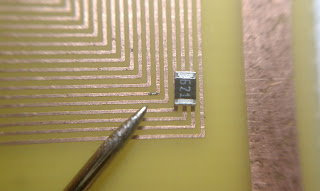Now that July has flown past with great speed I thought I would do a little summary of the QRP portable activities here at MW0BBU.
As you all know I am a great fan of SOTA and it is a great activity to get out of the shack and try out the QRP kit from up high.
Anyway, firstly the bands.
When Mark, MW0MJB, and myself did the first QRP portable from Foel Cwmcerwyn in June, 20m had produced many QSO's, so this became a starting band for me on my outings.
This however during July, proved to be very poor, resulting in only four qso's over the five outings.
30m didn't fair much better with a slight rise to six qso's.
40m however was the backbone of the portable activations, 148 qso's in total, which I must admit I was very happy with.
Bare In mind each activation was less than 2 hours.
As for countries, I managed to work 18 dxcc entities over the five outings and in these were a couple of Summit to Summit contacts which I was very pleased with.
A small list of Countries I have listed below...
F, OK, UA, PA, DL, G, I, EA, ON, HB9, SP, S5, MM, SM, LX, OE, LA and MW.
Just to share a few facts of the places I have been to in July...
Foel Cwmcerwyn, GW/MW-011, 536m / 1759ft, 31 QSO's
Mynydd Carningli, GW/MW-033, 347m / 1138ft, 32 QSO's
Frenni Fawr, GW/MW-028, 395m / 1295ft, 29 QSO's
Brandy Hill, GW/MW-037, 205m / 673ft, 18 QSO's
Rhos Ymryson, GW/MW-035, 327m / 1073ft, 48 QSO's
During these activations I have always used the FT817nd with an output of 5w into a 66ft Doublet.
This combination has served me well on my outings and the only grumble really I have on the FT817 is that it really needs a good CW filter.. which I must add is now on the shopping list.
Anyway, just to add again, its been great fun activating these summits and more fun again getting out of the roof space, sorry, Shack!!.
More are on the cards for August and just maybe some VHF SSB, I have been assured that SSB is the way to go on the hill tops, well after my recent attempts at FM I really hope so.
Anyway that's all for now, I hope you have enjoyed reading these little postings as much as I have done doing them.
Take care and all the best for now.
Steve...MW0BBU.


 I picked up this old Nemes Clarke receiver at a local hamfest. It is a VHF FM tube receiver.
I picked up this old Nemes Clarke receiver at a local hamfest. It is a VHF FM tube receiver.






















